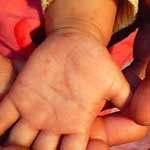
New research from the Menzies School of Health has revealed that alarming numbers of Indigenous children in Arnhem Land have scabies.
Their report shows that around 70 per cent of Aboriginal children are affected.
What are scabies?
Scabies is a skin infection caused by tiny mites that burrow under the skin to lay their eggs. New mites then hatch out of these eggs. This all makes skin really itchy, which makes the problem even worse, as the mites are spread further by scratching.
How do you catch it?
Scabies are spread from one person to another by direct physical contact over a prolonged period. Overcrowding in homes, schools, nursing homes and other institutions appears to be a major factor in the high levels of the condition in the Northern Territory.
The mites can even survive away from humans for up to 36 hours, so you can also catch them from things like bed sheets and clothes.
What are the symptoms?
Symptoms of scabies include intense itchiness, particularly at night and after a hot bath or shower. There may also be a bumpy, blistery rash.
In adults, the rash is most commonly found between fingers and on the wrists, armpits, stomach and genitals. In kids, the rash is more likely to be found on the face, the scalp, and the palms of hands and soles of feet.
Is it treatable?
Scabies is easily treated by a cream you can get from your doctor or Aboriginal Health Worker, but if left untreated it can lead to serious infection and major illnesses such as kidney and heart disease.
The Menzies School of Research team also believes that there may be a link between untreated scabies and rheumatic fever and rheumatic heart disease, which occur at the highest rates in the world in Aboriginal populations in the Northern Territory.
If you think that you or someone in your family might have scabies, visit your doctor or local Aboriginal Medical Service right away.
Comments are closed.